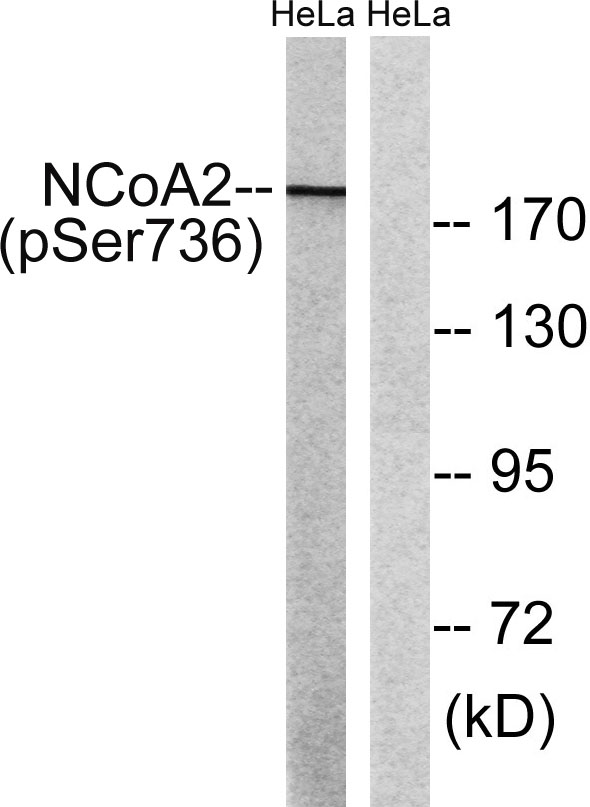GRIP-1 (phospho Ser736) Polyclonal Antibody
- Catalog No.:YP0825
- Applications:WB;IHC;IF;ELISA
- Reactivity:Human;Rat;Mouse;
- Target:
- GRIP-1
- Fields:
- >>Estrogen signaling pathway;>>Thyroid hormone signaling pathway
- Gene Name:
- NCOA2
- Protein Name:
- Nuclear receptor coactivator 2
- Human Gene Id:
- 10499
- Human Swiss Prot No:
- Q15596
- Mouse Swiss Prot No:
- Q61026
- Immunogen:
- The antiserum was produced against synthesized peptide derived from human NCoA2 around the phosphorylation site of Ser736. AA range:702-751
- Specificity:
- Phospho-GRIP-1 (S736) Polyclonal Antibody detects endogenous levels of GRIP-1 protein only when phosphorylated at S736.
- Formulation:
- Liquid in PBS containing 50% glycerol, 0.5% BSA and 0.02% sodium azide.
- Source:
- Polyclonal, Rabbit,IgG
- Dilution:
- WB 1:500 - 1:2000. IHC 1:100 - 1:300. ELISA: 1:5000.. IF 1:50-200
- Purification:
- The antibody was affinity-purified from rabbit antiserum by affinity-chromatography using epitope-specific immunogen.
- Concentration:
- 1 mg/ml
- Storage Stability:
- -15°C to -25°C/1 year(Do not lower than -25°C)
- Other Name:
- NCOA2;BHLHE75;TIF2;Nuclear receptor coactivator 2;NCoA-2;Class E basic helix-loop-helix protein 75;bHLHe75;Transcriptional intermediary factor 2;hTIF2
- Observed Band(KD):
- 180kD
- Background:
- The protein encoded by this gene functions as a transcriptional coactivator for nuclear hormone receptors, including steroid, thyroid, retinoid, and vitamin D receptors. The encoded protein acts as an intermediary factor for the ligand-dependent activity of these nuclear receptors, which regulate their target genes upon binding of cognate response elements. This gene has been found to be involved in translocations that result in fusions with other genes in various cancers, including the lysine acetyltransferase 6A (KAT6A) gene in acute myeloid leukemia, the ETS variant 6 (ETV6) gene in acute lymphoblastic leukemia, and the hes related family bHLH transcription factor with YRPW motif 1 (HEY1) gene in mesenchymal chondrosarcoma. Alternative splicing results in multiple transcript variants. [provided by RefSeq, Mar 2016],
- Function:
- disease:Chromosomal aberrations involving NCOA2 may be a cause of acute myeloid leukemias. Inversion inv(8)(p11;q13) generates the MYST3-NCOA2 oncogene, which consists of the N-terminus part of MYST3/MOZ and the C-terminus part of NCOA2/TIF2. MYST3-NCOA2 binds to CREBBP and disrupts its function in transcription activation.,domain:Contains 2 C-terminal transcription activation domains (AD1 and AD2) that can function independently.,domain:Contains four Leu-Xaa-Xaa-Leu-Leu (LXXLL) motifs. The LXXLL motifs are essential for the association with nuclear receptors and are, at least in part, functionally redundant.,domain:The LLXXLXXXL motif is involved in transcriptional coactivation and CREBBP/CBP binding.,function:Transcriptional coactivator for steroid receptors and nuclear receptors. Coactivator of the steroid binding domain (AF-2) but not of the modulating N-terminal domain (AF-1). Requi
- Subcellular Location:
- Nucleus .
- Expression:
- Epithelium,Placenta,Spinal cord,Testis,
- June 19-2018
- WESTERN IMMUNOBLOTTING PROTOCOL
- June 19-2018
- IMMUNOHISTOCHEMISTRY-PARAFFIN PROTOCOL
- June 19-2018
- IMMUNOFLUORESCENCE PROTOCOL
- September 08-2020
- FLOW-CYTOMEYRT-PROTOCOL
- May 20-2022
- Cell-Based ELISA│解您多样本WB检测之困扰
- July 13-2018
- CELL-BASED-ELISA-PROTOCOL-FOR-ACETYL-PROTEIN
- July 13-2018
- CELL-BASED-ELISA-PROTOCOL-FOR-PHOSPHO-PROTEIN
- July 13-2018
- Antibody-FAQs
- Products Images

- Immunohistochemistry analysis of paraffin-embedded human breast carcinoma, using NCoA2 (Phospho-Ser736) Antibody. The picture on the right is blocked with the phospho peptide.

- Western blot analysis of lysates from HeLa cells treated with TSA 400nM 24H, using NCoA2 (Phospho-Ser736) Antibody. The lane on the right is blocked with the phospho peptide.



